If you’re planning on going on the world’s most epic bucket list adventure by booking an Antarctica cruise there’s a few things you need to know first. In our ultimate guide we draw on our personal experience from multiple trips to share the how, who, when and why of travelling on a cruise to Antarctica!
Whether you’re ready to book, doing more research or simply interested in the idea of visiting Antarctica, there’s some very important things you need to know before dropping your hard-earned money on an expedition to the 7th continent.
We’ve been travelling and working in Antarctica since 2017, first as photographers and content creators, then as tour guides taking our own groups to this beautiful part of the world.
Now we work as expedition photographers for a number of different companies.
One thing we’ve discovered over the years is that no two Antarctic expeditions are the same – both in experience, and in service.
A quick Google will show that there are over 100 operators registered to IAATO, the International Association of Antarctica Tour Operators, to run trips down here, and then there are a handful of private enterprises and sailers that visit each year as well.
So how do you know which operator to book with? What time of year should you go? Why are some companies more expensive than others? And with so many different itineraries now available, which one should you choose?
That’s what we have set out to answer for you in this comprehensive guide.
By the end of this article you will have a great understanding of the differences between the best Antarctica cruises and which companies we recommend based on personal experience and intimate industry knowledge.
Ready to embark on the journey of a lifetime? Let’s dive into it!
READ MORE: Dive deep into our complete guide on travelling to Antarctica!
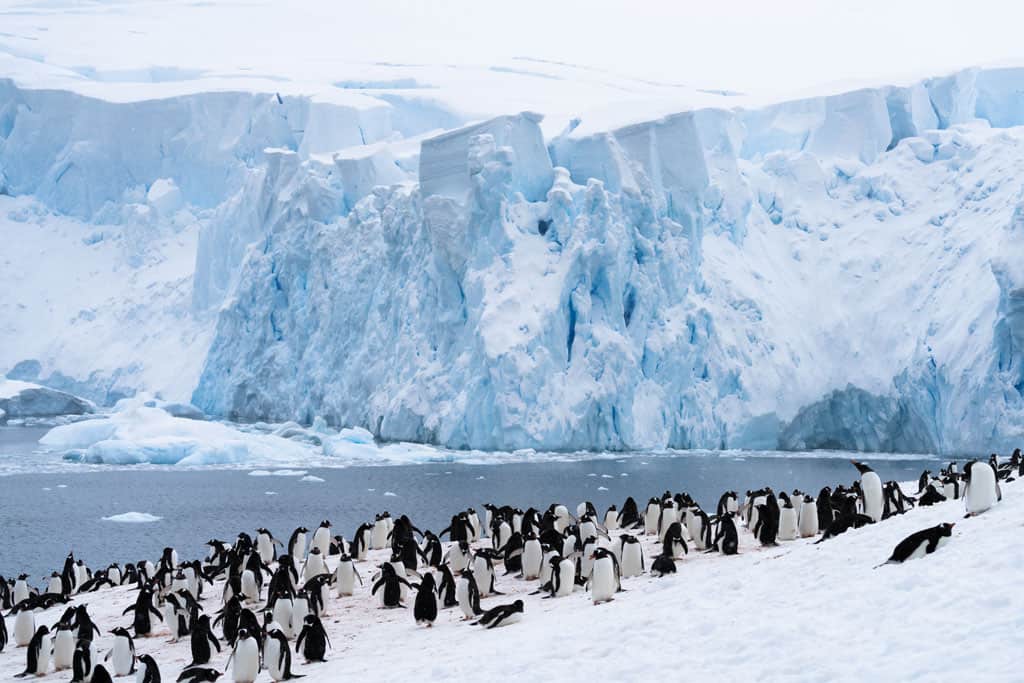
Table of Contents
- When is the Best Time to Go on an Antarctica Cruise
- Antarctic Cruise Itineraries
- Our Best Tips for Choosing the Right Antarctica Expedition for You
- The Best Antarctica Cruise Company – Our Recommendations
- Ship Size Matters on Antarctica Cruises
- How Much is a Cruise to Antarctica?
- How Long Should You Book to Visit Antarctica?
- 7 Days – Express (Fly the Drake)
- 10/11 Days – Classic Antarctic Peninsula
- 14 Days – Crossing the Antarctic Circle or Visit the Weddell Sea/Snow Hill
- 20 Days – Falkland Islands, South Georgia Island and Antarctica
- 21-24 Days – Trio and Crossing the Circle
- 28 Days – Ross Sea or ‘Sailing’ to Antarctica on a Yacht
- Activities and Excursions on Antarctica Trips
- Environmental Responsibility When Choosing an Antarctica Cruise Operator
When is the Best Time to Go on an Antarctica Cruise
All commercial operators that run trips to Antarctica during the Southern Hemisphere’s spring and summer months, stretching from late October to March, with the majority being between November and February.
Each month offers travellers a very different experience.
In November, as the continent emerges from its icy slumber, voyagers are greeted with pristine and untouched snowy landscapes.
Antarctica is at its most beautiful, but it also brings challenges for expedition teams due to weather, sea ice and snow density, meaning some landings might not be possible.
December and January are the peak months of the Antarctic summer, with the warmest temperatures (sometimes never dropping below freezing except at night), very long daylight hours, and the heartwarming sight of penguins nurturing their freshly hatched chicks.
It’s also the busiest time of year though on the Peninsula.
As the season progresses into February and March, the continent witnesses the awe-inspiring migrations of thousands of humpback whales and penguins shedding their feathers in the molting season.
The Peninsula might look it’s ‘dirtiest’ though, with much of the ground snow melted.
While the scenery is mesmerising throughout, the choice of month can tailor very different wildlife encounters and unique experiences.
We’ve written another full guide on the best time to visit Antarctica, but personally we prefer to travel early season (November) for landscapes and penguins, and late season (February and March) for whales.
After our very successful tour to Antarctica this season, we are going to be running another exclusive adventure down to the Peninsula in 2025, this time crossing the Antarctic Circle! Check out the tour page if you’d like to learn more.
Can You Travel to Antarctica in Winter?
Unfortunately tourists cannot visit Antarctica in winter due to the extremely cold weather and huge congestion in sea ice limiting access.
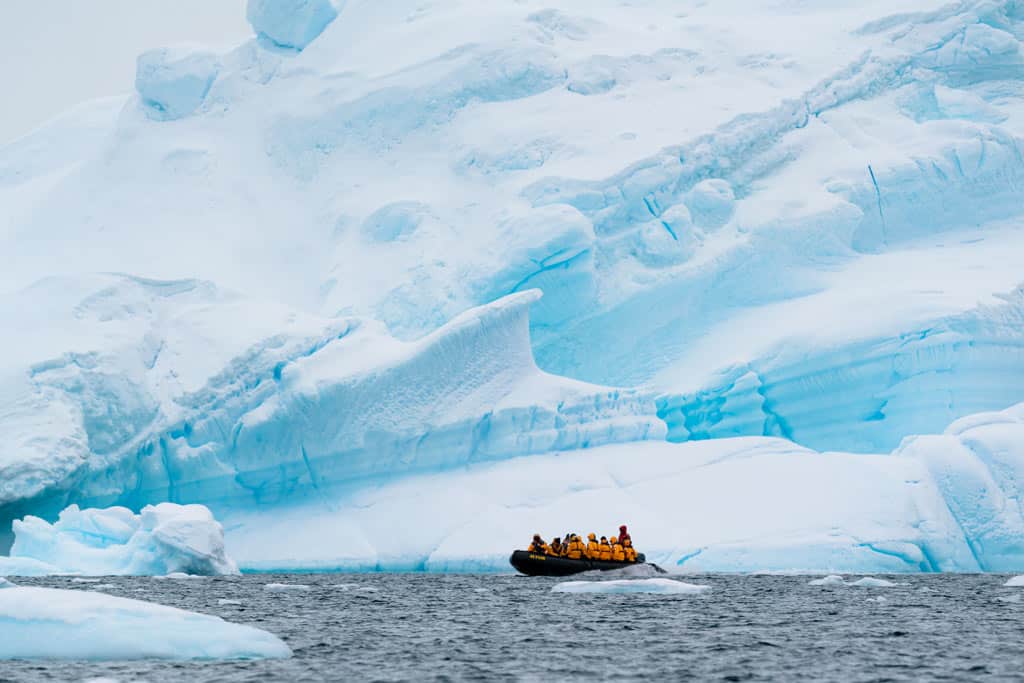
Antarctic Cruise Itineraries
There are a variety of different itineraries that are available to book for cruises to Antarctica.
Depending on your style, budget, interests and length of time available you’ll find some trips that are common (for good reason), and others that are very unique and only happen once every few years.
Here are the main Antarctic cruise itineraries you can book.
Antarctic Peninsula
The most common itinerary to Antarctica is a trip to the Antarctic Peninsula, most often departing from the port of Ushuaia in Argentina, at the very southern tip of South America.
These trips usually take around 10-12 days, with 5-7 days spent on the western side of the Antarctic Peninsula (the rest of the days are travelling over the Drake Passage), and no two trips are the same.
Some of the main destinations that you might visit on an Antarctic Peninsula cruise are:
- Deception Island
- South Shetland Islands
- Vernadsky Station
- Elephant Island
- Paulet Island
- Damoy Point
- Portal Point
- Cuverville Island
- Errera Channel
- Gerlache Strait
- Neko Harbour
- Lemaire Channel
Just because it’s the most common tour doesn’t mean it’s not worth doing. A Peninsula trip is truly mind-blowing, and allows you to officially step foot on the 7th continent.
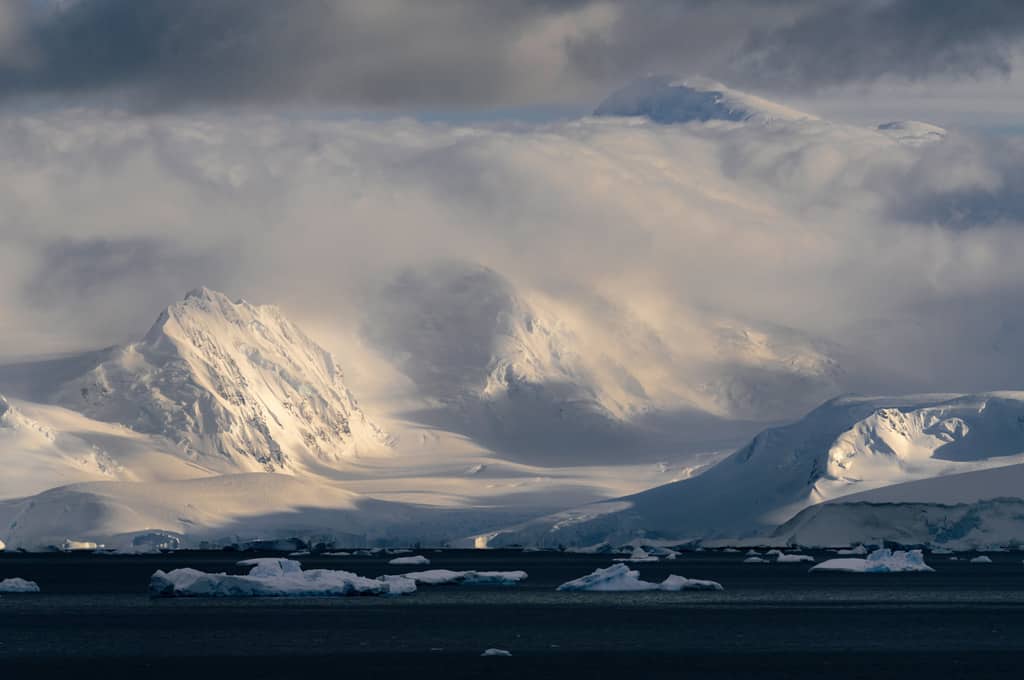
Crossing the Drake Passage vs Flying the Drake Passage
When researching Antarctic Peninsula cruises you’ll probably see that the majority of the itineraries sail across the Drake Passage, the infamous stretch of sea between South America and Antarctica, while a couple fly over the Drake to King George Island.
Many people are worried about the Drake Passage, which is understandable – it has the reputation for being the roughest sea in the world.
But one thing to keep in mind is that you’re not sailing to Antarctica in a little boat. You’re on a large expedition ship which is designed to handle much worse conditions than the Drake.
Seasickness might be a concern, but there’s medication to help with that and every trip has a doctor onboard.
The alternative is to fly the Drake from Punta Arenas in Chile, and while this is very tempting (it saves 4 days of travel and no rough seas to cross), there’s one very important thing to keep in mind:
Weather at King George Island is very unpredictable, and with just one scheduled flight a day allowed, cancellations do occur.
Visibility needs to be very clear down there and the right direction of wind for the pilots to land safely. If they don’t think they can land safely, they won’t depart Chile.
If your flight to Antarctica is cancelled on one day, the company usually has only one more attempt to get their guests down there before they have to forfeit their spot for the next company’s charter.
So if you’re unlucky and just so happen to get two days of bad weather in either Punta Arenas or Antarctica during your scheduled days of departure, your entire trip can be cancelled.
Aurora Expeditions alleviates this by hosting longer itineraries for their ‘Fly the Drake’ voyages, which maximises your chances of touching down in Antarctica – and if the weather is good, you get much more time down there than most departures.
For that reason we recommend sailing the Drake Passage to Antarctica unless you are 10% positive that you mentally cannot handle the sea crossing, or have your heart set on a particular itinerary with more time down on the Peninsula.
Plus if you do cross the Drake by sea you get that added sense of achievement.
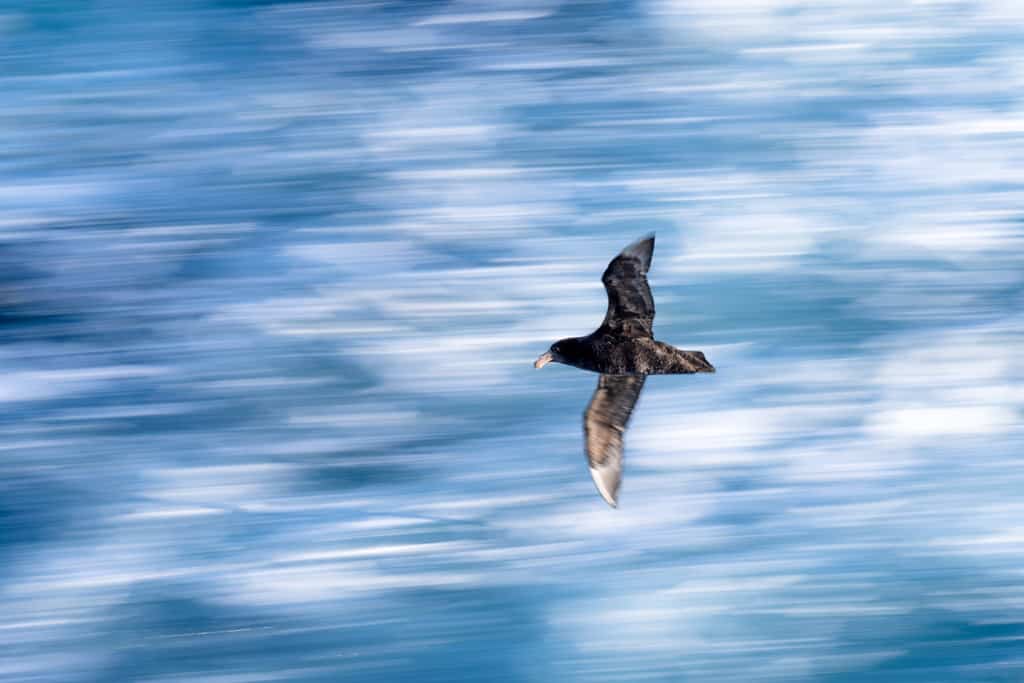
Crossing the Antarctic Circle
If stepping foot on the Antarctic continent isn’t enough, you can become one of the 0.001% of the human population who will ever cross the fabled Antarctic Circle at 66º southern latitude.
A few companies offer Antarctica tours that aim to cross the Circle (we say aim because nothing is guaranteed down here), and these itineraries are usually around 14 days (with 7-10 days on the Peninsula).
One thing to note is that there isn’t really anything ‘different’ once you cross the circle – the landscapes and wildlife are more or less same.
But you get more time in Antarctica, and get to venture to one of the most remote places on the planet.
Read more about Danco Island, Antarctica.
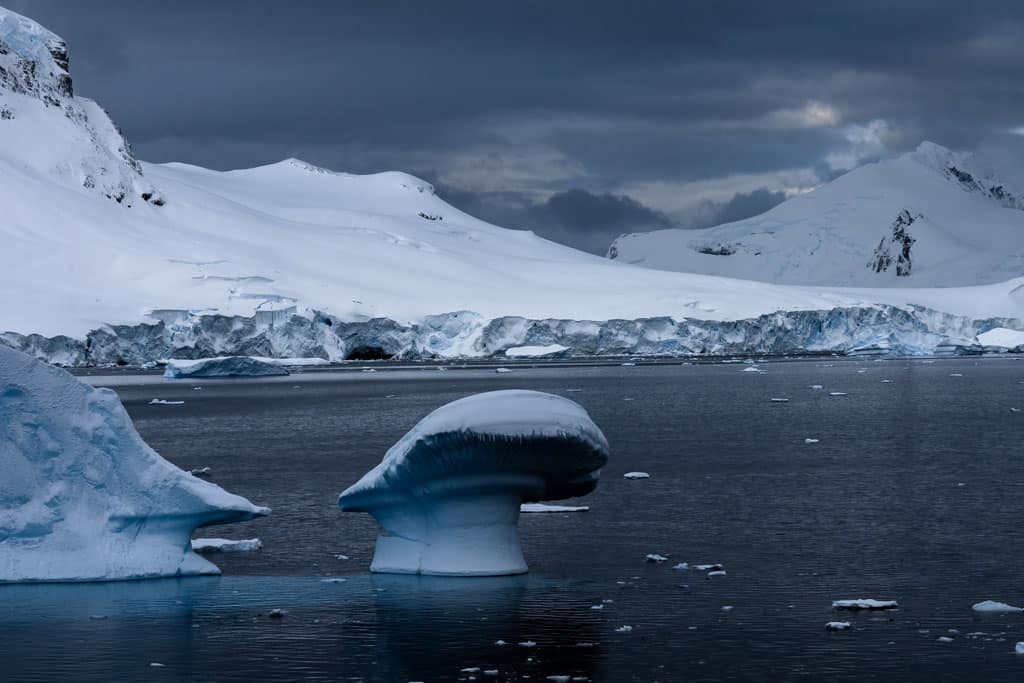
The Weddell Sea and Snow Hill
Some Antarctica tours go to the eastern side of the Peninsula and enter the Weddell Sea, which promises a different experience again and is not often visited by travellers.
There’s a lot of fascinating history in the Weddell Sea, especially around Sir Ernest Shackleton and his legendary tale of survival from the Endurance with his crew, so if this is of interest it’s worth looking for an itinerary that follows this path.
One unique tour that’s popped up recently, and has been pioneered by Quark Expeditions and now also offered by Ponant, is a trip to the emperor penguins of Snow Hill.
This trip is only offered once every couple of years in the early season (October) and requires either an icebreaker ship or a Class 1A ice-strengthened ship with helicopters, which allows guests to get close to the emperor penguin colony.
It’s known as one of the world’s greatest wildlife experiences, and has the price to match.
We’ve never personally done this but hope to one day.
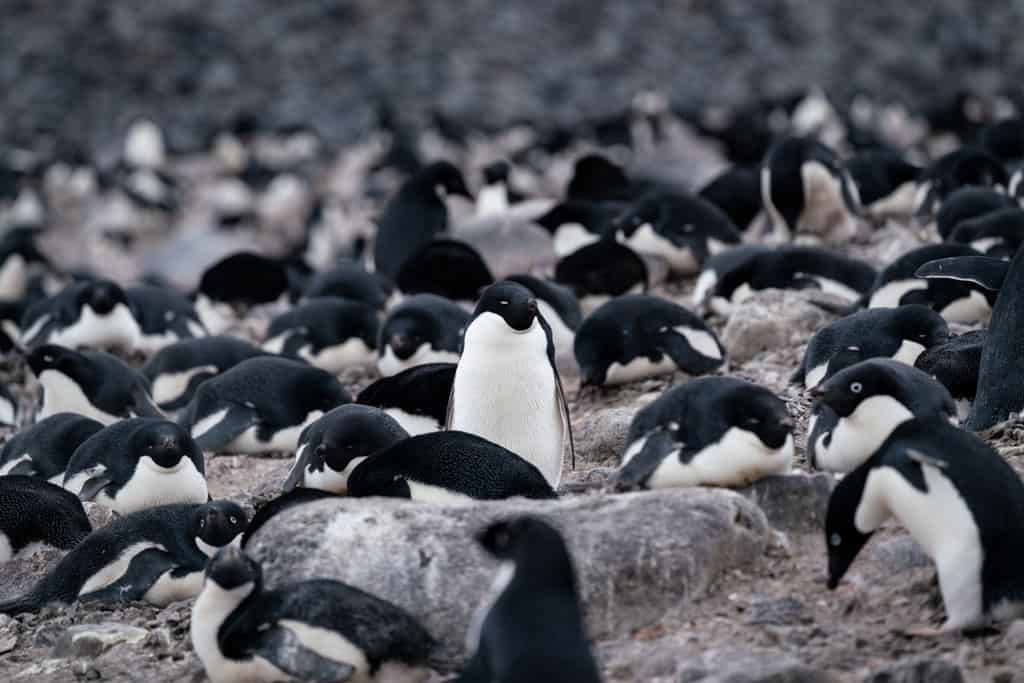
Falkland Islands (Islas Malvinas)
The Falkland Islands, or Isla Malvinas, is a truly spectacular archipelago about 1.5 days cruising from Ushuaia.
You’ll find some fantastic itineraries that include Falkland Islands, either as part of the trio (below), or sometimes starting in the Falkland Islands.
If you love British history, or just want something a little different, it’s worth looking at an itinerary that includes the Falklands.
The wildlife here, while not as dense as South Georgia, is especially fascinating for birdlife like albatross.
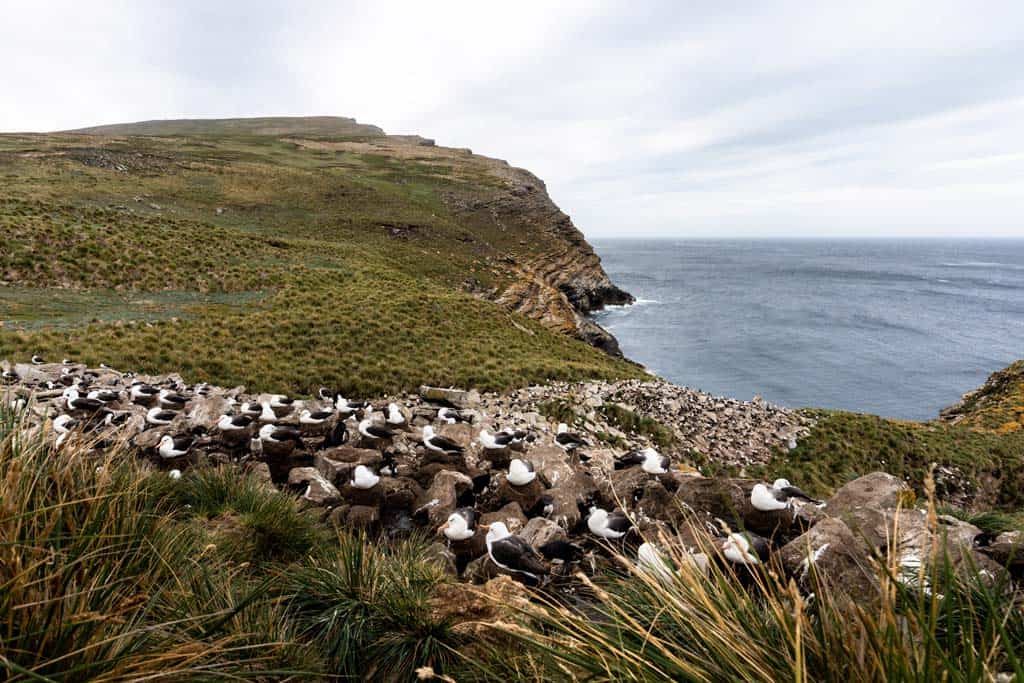
South Georgia
Known as the Serengeti of the Southern Ocean, South Georgia is one of the most incredible wildlife destinations on the planet.
Boasting dramatic mountains, huge glaciers and beaches filled with hundreds of thousands of king penguins, elephant seals and fur seals, it really is a sensory overload and we’ve seen quite a few people shed a tear when they’ve seen Salisbury Plain or St Andrews Bay for the first time.
In all honesty, as amazing as Antarctica is, most people who visit South Georgia end up saying that this spectacular island is their real highlight of the trip.
There are a few itineraries that only visit South Georgia (usually after flying into Stanley in the Falkland Islands), but the majority will either include the Peninsula and possibly the Falklands.
Adding on South Georgia adds significant expense to an Antarctic trip due to how remote it is, but it is 100% worth it.
Check out our guide on the best time to visit South Georgia based on our personal experience.

The ‘Trio’ – Antarctica, South Georgia and Falkland Islands
Considered to be the pinnacle of best Antarctic tours is a trip that includes the Antarctic Peninsula, South Georgia and the Falkland Islands, often referred to as the ‘trio’.
These itineraries are usually around 20 days long, with quite a few days spent at sea navigating between each destination, so if you can find a longer itinerary that includes more days at each place it’s worth exploring.
This is the Antarctic cruise itinerary we most recommend.
Our own group tour on the trio includes the most amount of days in each location available.
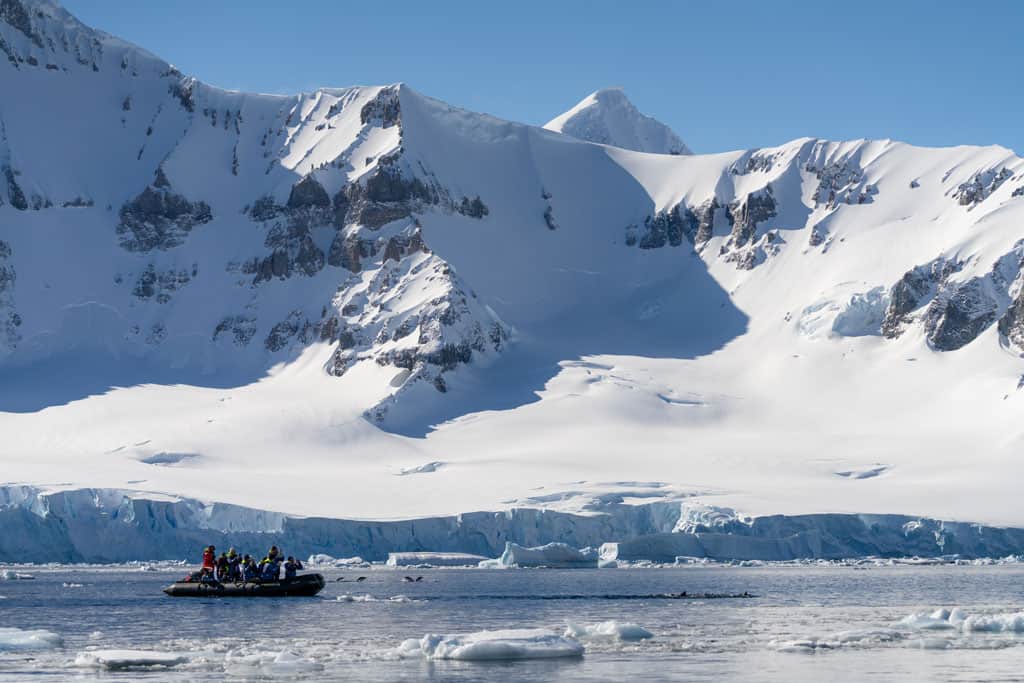
The Ross Sea from New Zealand or Australia
An Antarctic cruise to the Ross Sea from either New Zealand or Australia is a very rare occurrence, with only a small number of companies making the journey, and is usually booked by people who have been to the Peninsula before and want to see a different side of the continent.
A trip to the Ross Sea involves a lot of sea days and can be very expensive, but they visit very important research bases, follow the explorers Mawson and Shackleton’s history and includes penguin colonies not often seen, or located on the Macquarie Islands in the Subantarctic.
Heritage Expeditions is one such operator that runs two trips a year to the Ross Sea, via the Subantarctic Islands.
As of 2025 Aurora Expeditions, the award-winning Australian polar company, will be returning to the Eastern side of Antarctica from Hobart on their newest X-Bow ship, the Douglas Mawson.
CEO Michael Heath says, “We are equally delighted to be offering passengers new itineraries departing from Australia as part of the ship’s inaugural season, including an exploration of Mawson’s Antarctica, which will visit Mawson’s Huts at Cape Denison, Commonwealth Bay, and New Zealand’s Subantarctic Islands.
“AE Expeditions has pioneered expedition travel to the world’s most remote places for more than three decades, and we know that exploration is not just about what you see, but how you see it.
“That is why we are committed to delivering life changing experiences with the newest, most advanced technology available, and with the most experienced and passionate team in the industry,” he added.
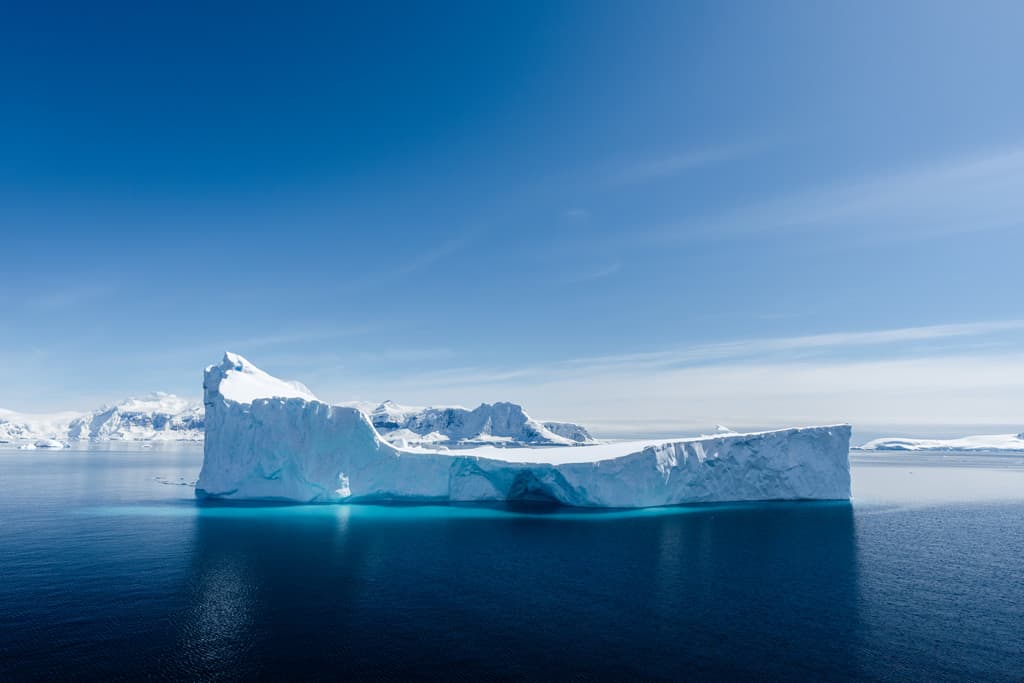
Our Best Tips for Choosing the Right Antarctica Expedition for You
Choosing the right Antarctic cruise is essential for crafting an unforgettable polar experience.
This remote, icy frontier promises unparalleled adventures and sights, but the vast array of cruise options available can be overwhelming.
From the more than 100 different companies that operate down there, different ship sizes and amenities and of course the nuances of itineraries and activities, every detail plays a big part in shaping your journey.
With such a significant investment of time, money, and anticipation, it’s crucial to make informed decisions.
As you dream of gliding past enormous tabular icebergs and observing wildlife in its purest habitat, here are our best tips to ensure you select the right Antarctic cruise and best Antarctica tour company that aligns perfectly with your expectations and desires.
The Best Antarctica Cruise Company – Our Recommendations
With more than 100 operators running trips to Antarctica it’s very easy to be overwhelmed with who to go with.
And if you ask for opinions from a travel agent, they’ll just tell you the one that either a) pays them the most commission or b) is going to offer them a free trip if they sell X number of spots.
Then if you ask in one of the popular Facebook groups, the answer will almost inevitably be whichever company that particular person went with, and they have nobody else to compare them to.
We’ve travelled with a whole variety of polar operators, and here’s our top 5 recommendations and why.
Aurora Expeditions
Australian enterprise Aurora Expeditions has carved a niche for itself in the realm of polar travel for being a bit more adventurous than the rest, without compromising safety.
Their focus leans towards a genuine and immersive experience rather than mere sightseeing, with activities such as snorkelling, scuba diving and stand-up paddleboarding available to purchase.
Aurora has a small fleet of luxury ships and a fantastic team of seasoned expedition guides, so travellers are in good hands.
They are also B Corp certified, a testament to their commitment to sustainability, and as of July 2024 have committed to capping all expedition numbers to 130 passengers maximum.
It’s just another step into minimising their footprint as they travel across the polar regions.
“Our pioneering spirit leads us to explore rarely visited locations and introduce unique itineraries
for every season,” Hayley Peacock-Gower tells us, who is the Chief Marketing Officer of Aurora Expeditions.
“We pride ourselves on innovation and pushing the boundaries of discovery to provide unique, immersive experiences for our expeditioners while maintaining a light footprint.
“We’re constantly seeking new places to explore while on a voyage and want to share these findings with our expeditioners, so we’re comfortable adjusting our schedule to make the most of unexpected wildlife or scenic displays.”
In 2025 Aurora Expeditions will also be welcoming the brand new, 130pax X-BOW vessel, the Douglas Mawson, to their fleet, which will prove to be one of the most capable, luxury ships in the industry.
READ MORE: Check out our full Sylvia Earle ship review article, one of the luxury X-BOW vessels operated by Aurora.
Their trips however are on the pricier side, which is something to consider. In our opinion though the quality product that you receive with Aurora is worth the price, and they are known in the industry for being one of the top operators.
Working as photographers, content creators and guides in Antarctica we have been fortunate enough to travel with quite a few different companies down here.
In 2025 after years of hearing incredible things about their product from both guests and crew, we will be joining forces with them to work in the polar regions.
EXCLUSIVE – We have partnered with two of the world’s top polar tour operators, Aurora Expeditions and Intrepid, to offer readers of NOMADasaurus a very special deal on any trip to Antarctica or the Arctic! Contact us (hello@nomadasaurus.com) if you’d like to learn more about these exclusive discounts.
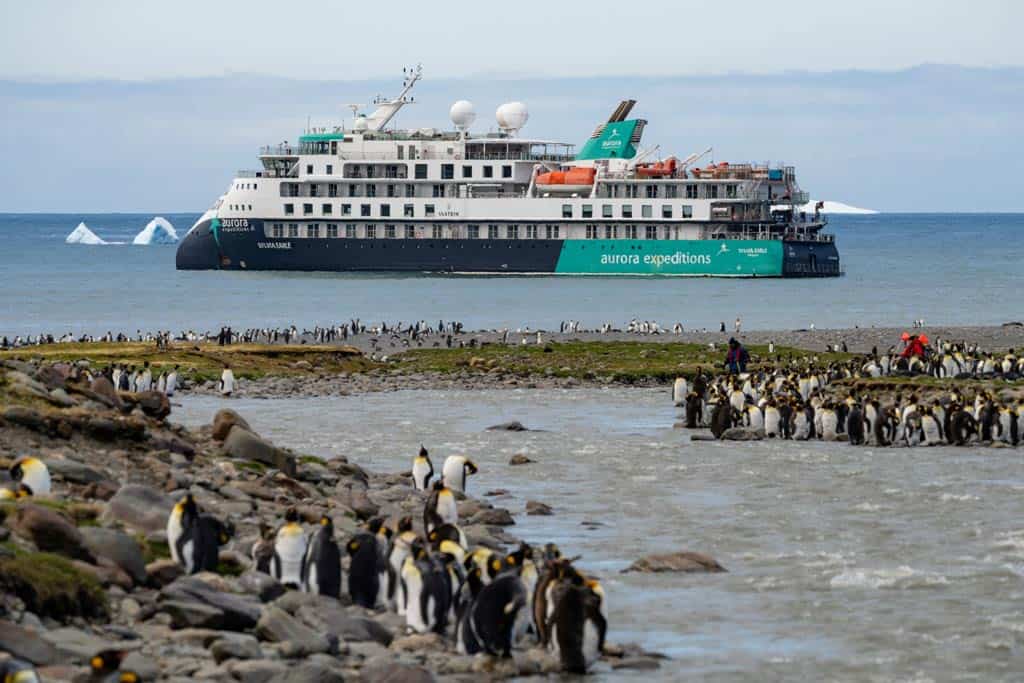
Quark Expeditions
Canadian company Quark Expeditions is one of the true pioneers in polar adventures.
Established in 1991, this trailblazing company has spent decades perfecting the art of delivering unparalleled experiences in the planet’s most remote regions.
They were the the first to organise trips to Snow Hill and revolutionised North Pole tours, so they’re always looking for what’s next in the world of polar voyages.
Quark has an impeccable safety record and has a fleet of ice-class vessels, including the new, luxurious MV Ultramarine, which allows them to execute really unique itineraries.
All of their ships have under 200 passengers too, meeting IAATO regulations for number of people off the ship at any one time.
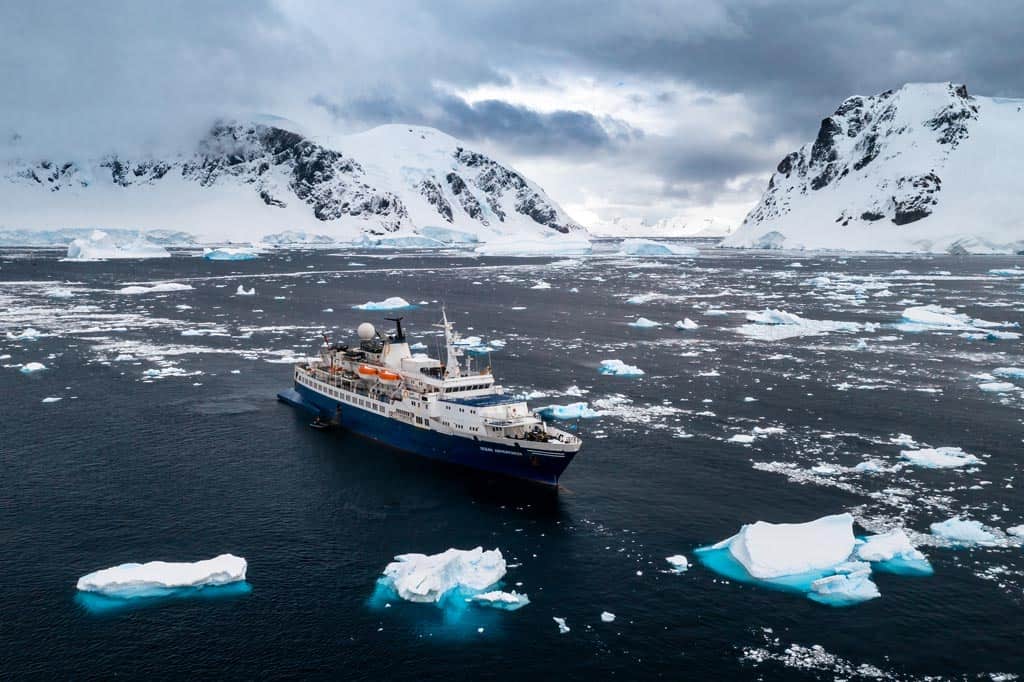
Hurtigruten
One of the most famous names in polar travel, Hurtigruten, hailing from Norway and originally started as a ferry company, offers excellent budget-friendly trips to the Antarctic and Arctic.
Their itineraries are fantastic and the service for guests is excellent. They also have an excellent onboard science program.
However, their ships are very large, with between 250 and 500 passengers on each trip, meaning your actual time spent off the ship is limited.
If price is a major factor for you they are a good option and they do have a great product, but the size of their ships is something to consider. Remember, in Antarctica, bigger isn’t better.
Intrepid
Intrepid is famous around the world for organising amazing small group tours around the world, and as of recently have now moved into the polar regions.
They operate a large, older ship, the Ocean Endeavour, but limit passengers to 199 to skate under the 200 pax limit.
Their trips attract a younger demographic and a lower price point, but they’ve worked hard to secure some of the best expedition team members in the industry.
Jarryd is now working with Intrepid as an Expedition Photography Guide during their Antarctic season, teaching others how to create beautiful images in the polar regions.
The average age onboard an Intrepid trip is around 45, so it’s an entirely different atmosphere compared to something like Ponant or Lindblad that has an older average age.
Neither is better or worse, just something to consider based on your own style.
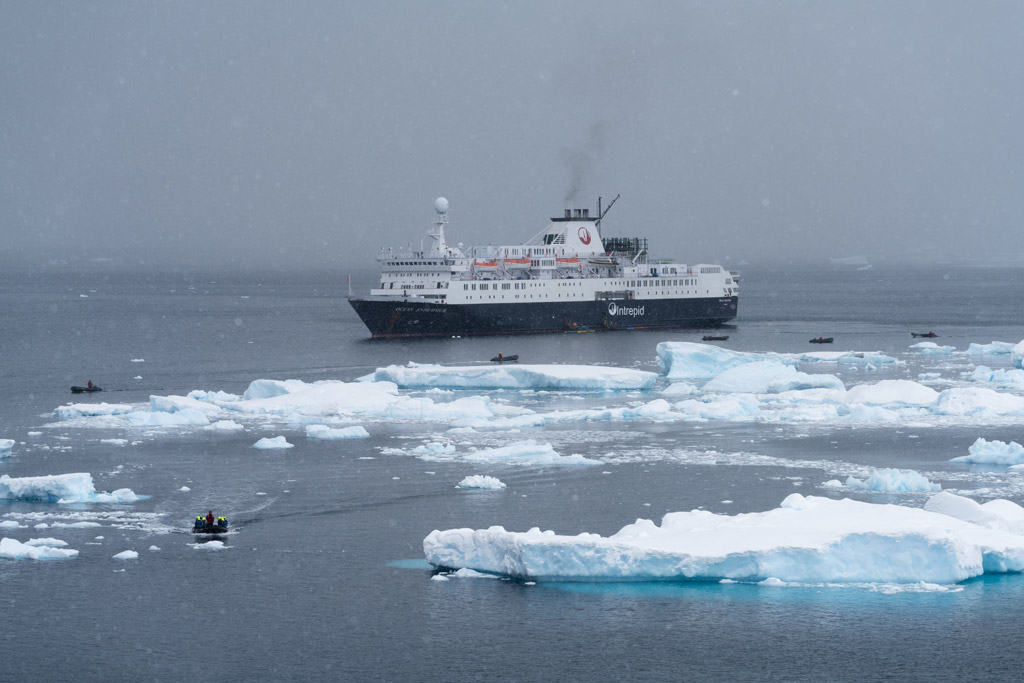
Scenic
Scenic is an old hand in the luxury river cruise industry, they have since branched out into polar tours and are doing an amazing job at it with their beautiful ships and brilliant expedition team.
They have some pretty unique offerings, including a submarine that you can book for seeing Antarctica beneath the surface, and really fun activities.
Many of our expedition guide friends are now working at Scenic as well, and we can vouch for just how good they all are.
Other Operators
Of course that’s just scratching the surface and there is plenty of other operators out there. These are some others worth considering:
- Islands and Ice – Small tour company run by the legendary expedition leader David Sinclair, chartering the MV Polar Pioneer for adventurous trips of less than 50 people.
- Ponant – Uber-luxurious cruise operator. If you like your icebergs with a side of caviar underneath a chandelier, this is the company to go with.
- G Adventures – Similar to Intrepid in that they focus primarily on small group trips in other parts of the world, but their Antarctic product is quite good.
- Oceanwide Expeditions – Small groups with under 100 passengers, operating some cool itineraries.
- Albatros Expeditions – Nice, sustainable operator with great ships and decent expedition team.
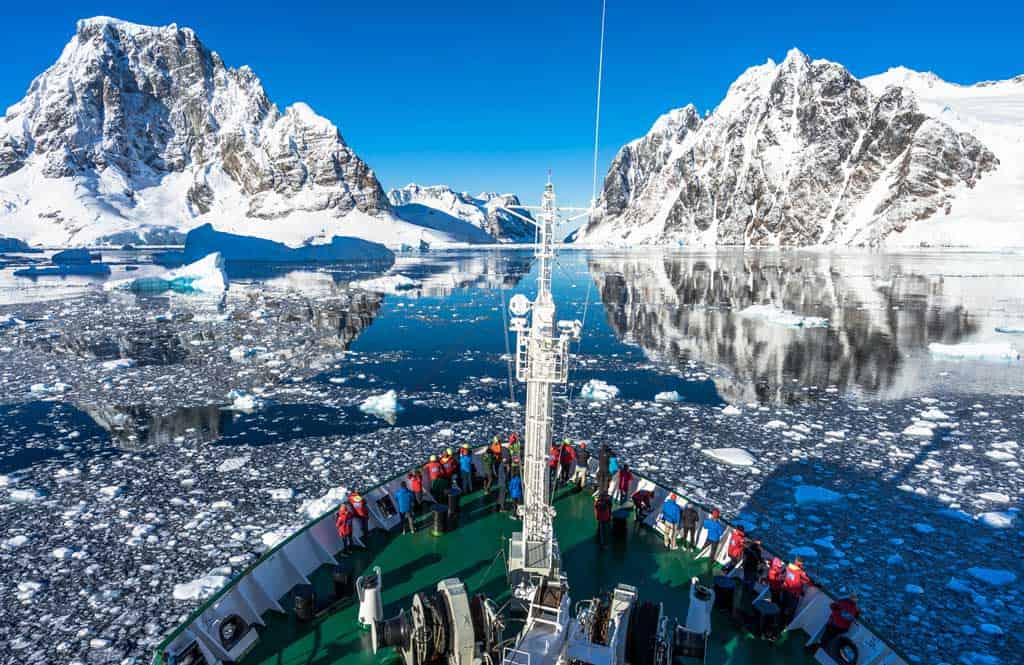
Ship Size Matters on Antarctica Cruises
You might be tempted to book a tour onboard a larger cruise ship for a number of reasons.
More space and amenities, cheaper price, familiarity with a particular company such as Carnival, etc.
But trust us when we say bigger is not bigger in Antarctica!
IAATO, the body that regulates tourism in Antarctica, has strict rules around the number of passengers from any one ship that can leave the vessel at any one time.
They are:
- Less than 100 passengers – Everybody can leave the ship at the same time and step foot on the continent at the same time
- Between 101-200 passengers – Everybody can leave the ship at the same time, but only 100 people can step foot on the continent at any one time, so the rest of the guests will often do a zodiac cruise
- Between 201-500 passengers – Only 200 people can leave the ship at any one time, so 100 maximum people will land on shore, 100 people maximum will go on a zodiac cruise and the rest waits on the ship for a group to come back.
- More than 501 passengers – Nobody leaves the ship at all.
So as you can see if you are booking a trip to Antarctica on a large ship, you run the risk of not even getting off the ship.
You don’t really want to spend all that money just to get down there and look at the continent from your balcony.
For that reason we don’t recommend booking a trip on a vessel that carries any more than 200 people total, and ideally less than 100 people if you can find one.
Let us say that again;
DO NOT BOOK A TRIP WITH MORE THAN 200 PASSENGERS!
Besides that, there’s other considerations when it comes to ship size and choosing the best Antarctica expedition.
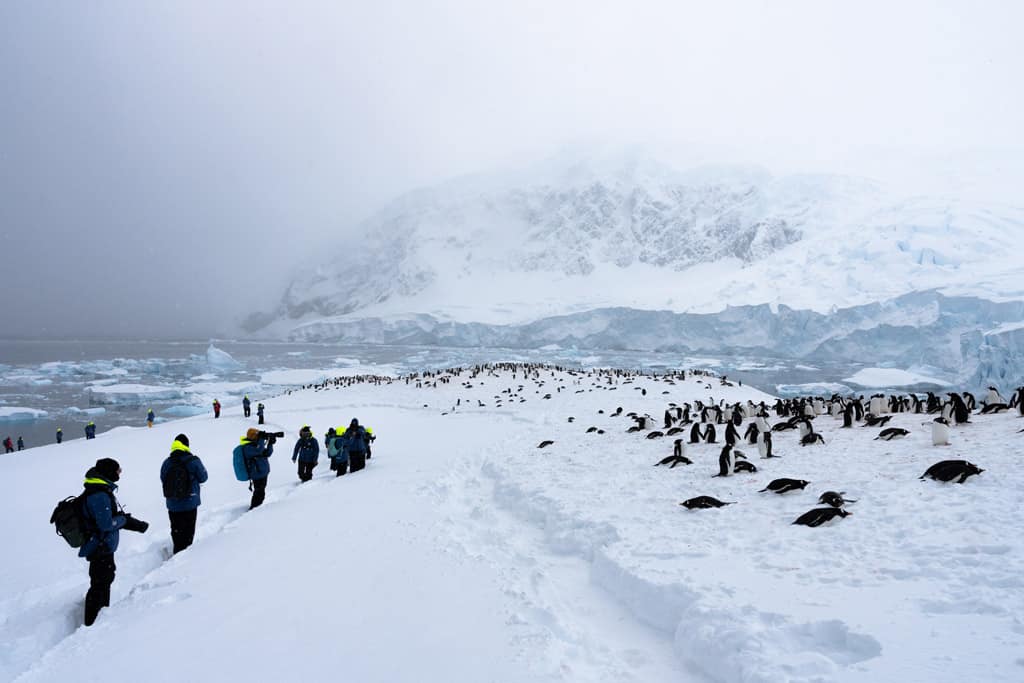
Navigating Antarctic Waters
Smaller ships have much better manoeuvrability, which allows them to navigate through narrow channels and into tight bays to allow you to access Antarctica close up.
A smaller ship often means a shallower draft too, so they can get into some areas that may not be deep enough for larger vessels.
Intimacy
This might not be something you think about, but when you book a smaller ship you have a greater sense of intimacy with your fellow guests and expedition team.
There is often just the one dining room and one, maybe two, lounges to relax in. That means everybody congregates in the same areas and it doesn’t take long to start getting to know everybody.
The larger ships can feel like a labyrinth, and we’ve heard of people going entire expeditions and not ever finding the library for example.
Personally, we prefer smaller ships.
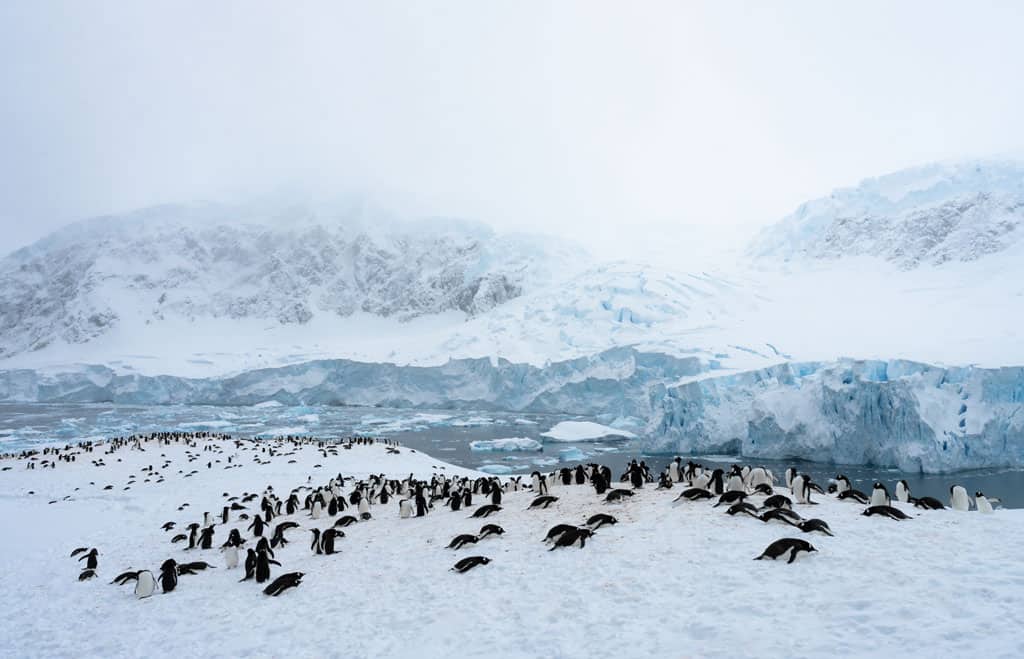
How Much is a Cruise to Antarctica?
Heading off on an Antarctic adventure is both a dream and a significant financial undertaking.
With such a wide variety of cruise options, ranging from small, older vessels to high-end luxury ships, it can be hard to determine what is worth spending your money on.
At the budget-friendly end, less extravagant ships may lack the luxurious amenities, but they often deliver an authentic, intimate connection with the Antarctic wilderness.
These ships focus on the adventure and Antarctica expedition with an authentic flare, where you feel encouraged to be out on deck or in the lounge areas when you’re onboard rather than sprawled out in your cabin.
On the other hand, luxury cruises offer plush accommodations, gourmet dining, spa services, and even onboard entertainment.
Some of them even have helicopters and submarines onboard, opening up a whole new world that isn’t possible with other operators.
While these amenities come at a premium, it ensures an unparalleled level of comfort amidst a wild Antarctic backdrop.
Essentially, you get what you pay for when it comes to the ship; the more you pay, the nicer the onboard experience.
So how much should you expect to pay for a cruise to Antarctica?
On average, USD$10,000 per person for the standard itinerary, and around USD$18,000 for a trip that includes the Falkland Islands and South Georgia.
Of course you can sometimes find trips for as long as USD$5,000 per person if you book it super last minute on a special deal, and ones as expensive as USD$50,000 or more.

Does a More Expensive Trip Mean a Better Experience?
However when you look at the individual itineraries for different operators, you might notice something interesting…
They are often the exact same, whether you’re playing $8,000 or $20,000.
A typical 10-day ‘Best of Antarctica’ itinerary, which actually only includes 4.5 days in Antarctica, has the same number of days and excursions on the continent, often doing the same thing (zodiac cruises, landings, ship exploring, etc).
Adventure activities, such as kayaking, stand-up paddle-boarding and camping, usually have an additional cost no matter which company you’re with too.
So really, in most situations you’re paying more money for a nicer ship and cabin.
There are exceptions of course, especially if your ship has helicopters.
But if the company you’re looking at doesn’t have any obvious benefits such as helicopters or more days at sea, most of the price increase is for better food and nicer rooms.
Is that worth it the difference in cost?
That’s a question only you can answer.
Look further into Antarctica trip costs with our complete guide!
Either way, it’s paramount to really look into what’s included in your package. Some voyages may seem very cheap upfront but then charge extra for essentials like shore excursions, gear rentals, or even certain onboard facilities.
All of the operators we recommend though include daily excursions, all meals and gear rental included, regardless of price and itinerary.
And if you have some flexibility in your travel plans, there’s a big potential to lock in some remarkable last-minute deals.
Subscribe to the newsletters of Antarctic cruise operators or follow their social media channels to see what’s available.
Or get in touch with us for the best price possible with our current favourite operator, Quark Expeditions, even better than what they advertise to the public.
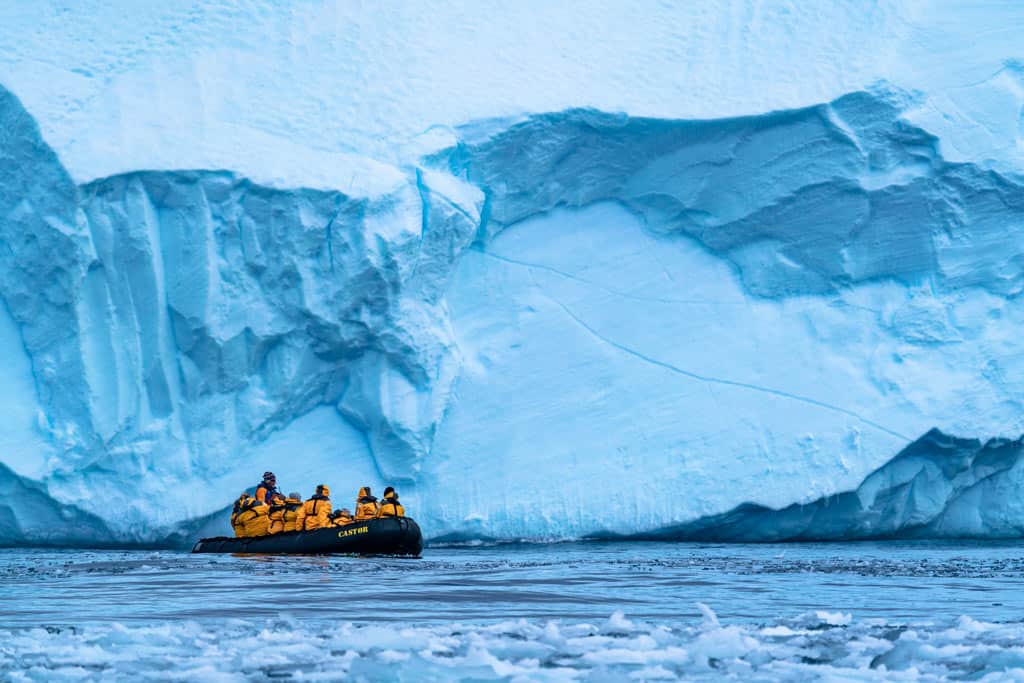
How Long Should You Book to Visit Antarctica?
The length of Antarctica cruises vary quite a bit, with options ranging from a week right up to an entire month.
The length of your voyage determines not only how much of Antarctica you get to explore but also how much time you spend on the open sea versus the continent itself.
The sweet spot is the classic 11-day itineraries, which just visits the Peninsula, but let us break down the general ones you’ll find.
One thing to keep in mind though is that the length of time the companies advertise is not how much time you get to spend in Antarctica.
For example an 11-day itinerary often means just 4-5 days in Antarctica, and the rest of the time is spent before the trip in Buenos Aires or Ushuaia and the two days each way on the Drake.
Misleading? Perhaps. But that’s just what it is.
7 Days – Express (Fly the Drake)
For those that are on a super tight schedule or really, really don’t want to cross the Drake, you can fly down to join your cruise to Antarctica.
You’ll usually have one full day in Punta Arenas, Chile, then schedule to fly to King George Island the next day. Then you’ll have 4 days on the ship, before flying back for another night in Punta Arenas.
10/11 Days – Classic Antarctic Peninsula
This is the trip most people do.
You’ll meet your group in Ushuaia on the first day, then jump on the ship the next day (or start in Buenos Aires and take a charter flight the next morning).
After that it’s two days sailing across the Drake Passage, 4 days to explore Antarctica, then two days back to Ushuaia.
You wake up in Ushuaia and the trip either ends there for you, or you jump on a charter flight back to Buenos Aires.
14 Days – Crossing the Antarctic Circle or Visit the Weddell Sea/Snow Hill
Essentially the same structure as above, but you’ll have an extra couple of days to travel the distance required to hopefully cross the Antarctic Circle, or sail around to the east side of the Peninsula to get into the Weddell Sea and maybe see the emperor penguins.
20 Days – Falkland Islands, South Georgia Island and Antarctica
Our personal favourite length, as it ticks off all the major highlights.
Starting in Buenos Aires or Ushuaia, you then have one sea day to make it to Falkland Islands, then usually have two days exploring around the British archipelago.
Then it’s two more days at sea to get to South Georgia, with 3 to 4 days spent visiting the most spectacular place on earth.
You’ll then have a massive three sea days to get to the Peninsula for your 4 days hanging around here.
Then back across the Drake you go.
21-24 Days – Trio and Crossing the Circle
As above, but with a few extra days to cross the Antarctic Circle.
Basically the ultimate Antarctica trip.
28 Days – Ross Sea or ‘Sailing’ to Antarctica on a Yacht
If you have a month up your sleeve you can either take the historic Ross Sea trips from New Zealand or Tasmania, or be a real adventurer and jump on tall ship to sail down to Antarctica.
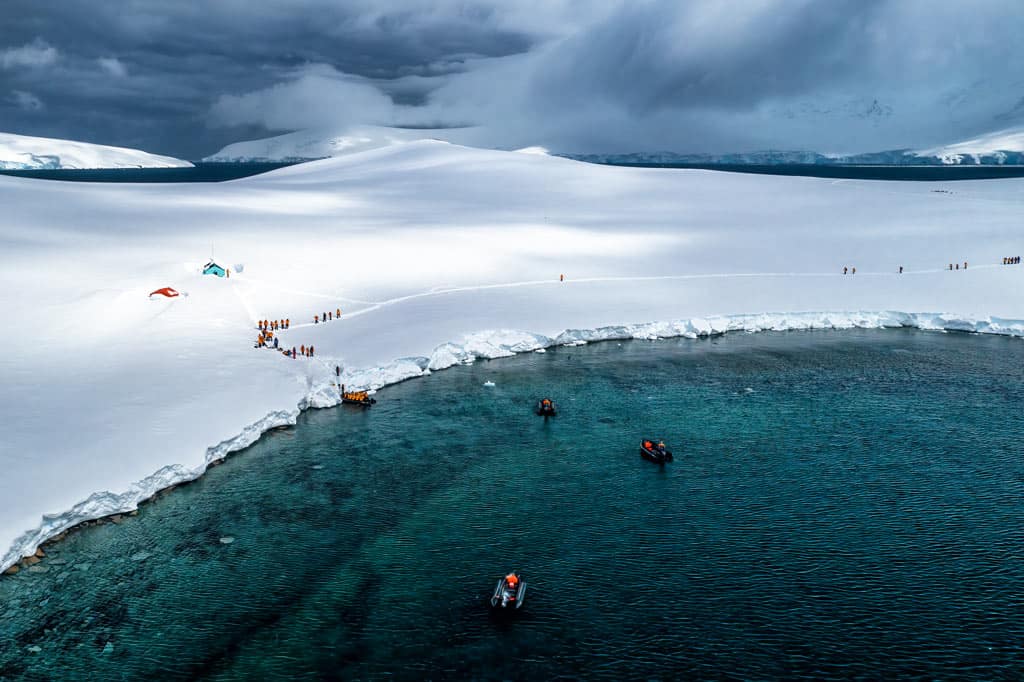
Activities and Excursions on Antarctica Trips
When you’re heading down to the Antarctic region on an expedition cruise ship there’s quite a few activities that you can do.
Some are included in the price for everybody, and others have limited availability for an additional cost.
Here’s what you can expect for what to do in Antarctica:
Zodiac Cruises
There are no ports in Antarctica that allows for a ship to dock, so the only way to get off the ship and explore land is on a small, inflatable boat called a Zodiac.
Zodiacs not only allow you to step food on land, but they also let you get up close to icebergs, glaciers, and wildlife.
Zodiac cruises offer an intimate and immersive experience, allowing passengers to navigate through stunning icy waterways.
The frequent Zodiac landings, integral to most Antarctic cruises, transport passengers from the ship to the very heart of the continent.
Setting foot on the Antarctic mainland, or one of its many islands, is an indescribable moment.
Zodiac excursions are included in most small ship cruises.
Landings and Hiking
Once you’ve used a zodiac to get to shore you have a few other included activities – landings and hiking.
You can wander around a predetermined path, set out by the expedition guides, to visit research stations and viewpoints, or get closer to penguin colonies.
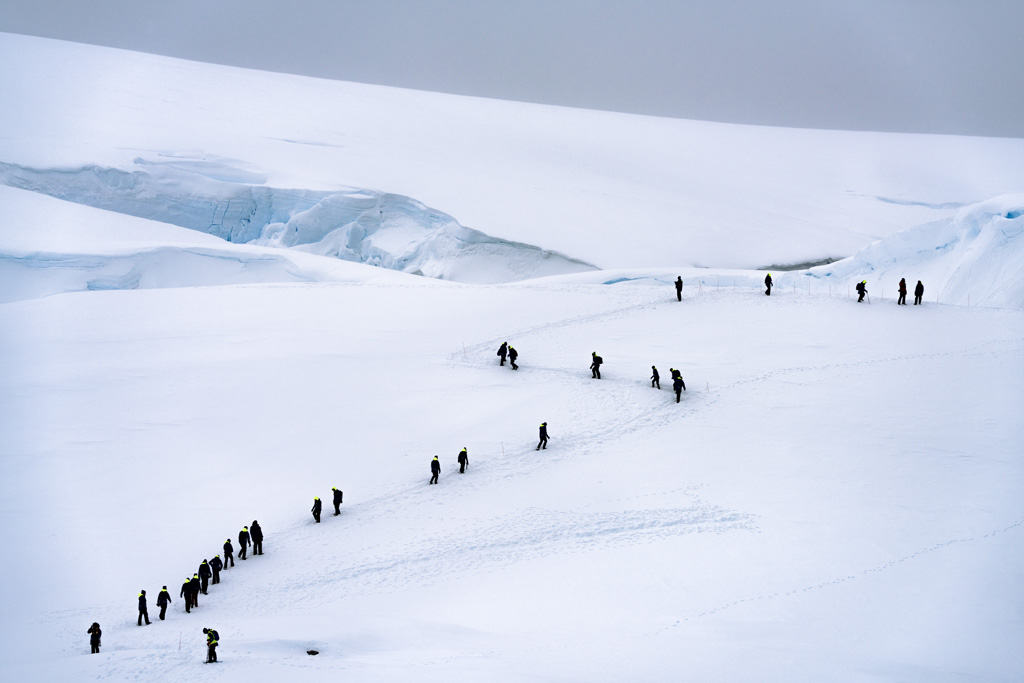
Onboard Seminars
Any decent company, like the ones we recommend above, will also have daily onboard seminars from guides, scientists, biologists and historians to share information about the continent.
They fill the sea days and evenings, and you shouldn’t miss any.
Polar Plunge
If you want the ultimate bragging rights after your trip to Antarctica make sure you don’t miss the polar plunge.
What is it? Well, it’s going for a swim in Antarctica, of course.
You wander down the gangway, strap a harness and rope to you, and literally jump off a perfectly good (and warm) ship into the icy water.
It’s included in most trips, weather permitting, and you’ll get to come home with some cool photos to prove you did it.
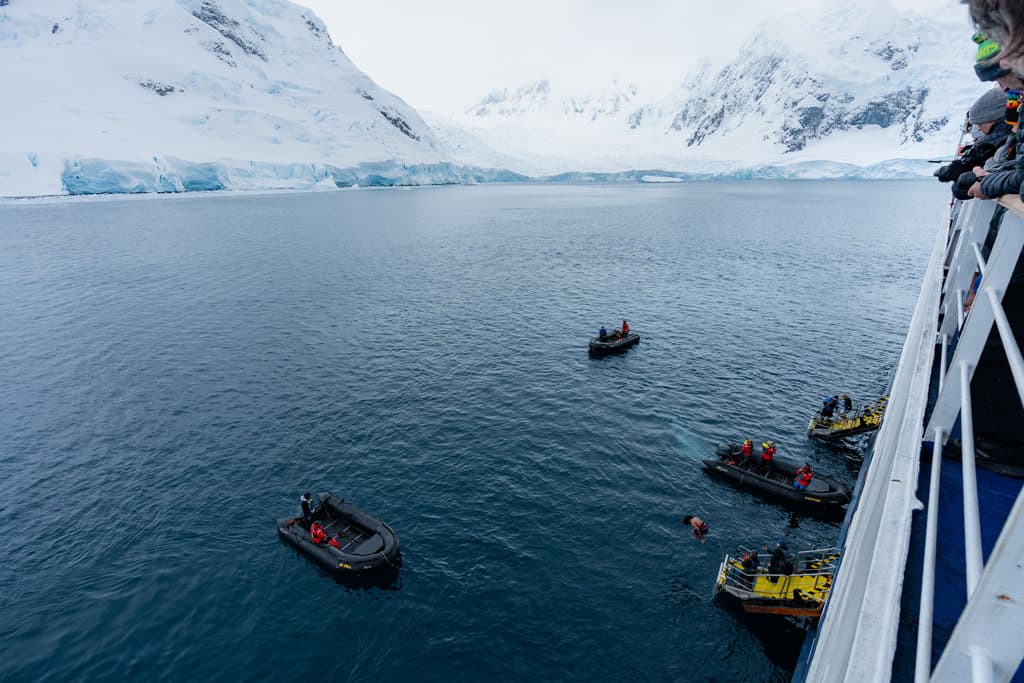
Wildlife Watching
Of course Antarctic wildlife watching is always free and included in your trip.
Some of the animals you could see are many penguin species such as gentoos, adélie penguins, Magellanic penguins, rockhoppers, chinstraps, king penguins, emperors (if you’re super lucky) and macaronis.
You can see lots of whales too such as humpback whales, minke whales and orca (killer whales), and occasionally blue or southern right whales in the Southern Ocean.
Sea birds also make part of the abundant wildlife, with albatross, skuas, petrels and terns commonly found.
And if you like seals in their natural habitat, there’s southern elephant seals, weddell seals, ross seals, leopard seals, crabeater seals and Antarctic fur seals.
Sorry, there’s polar bears down here. You’re thinking of the Arctic.
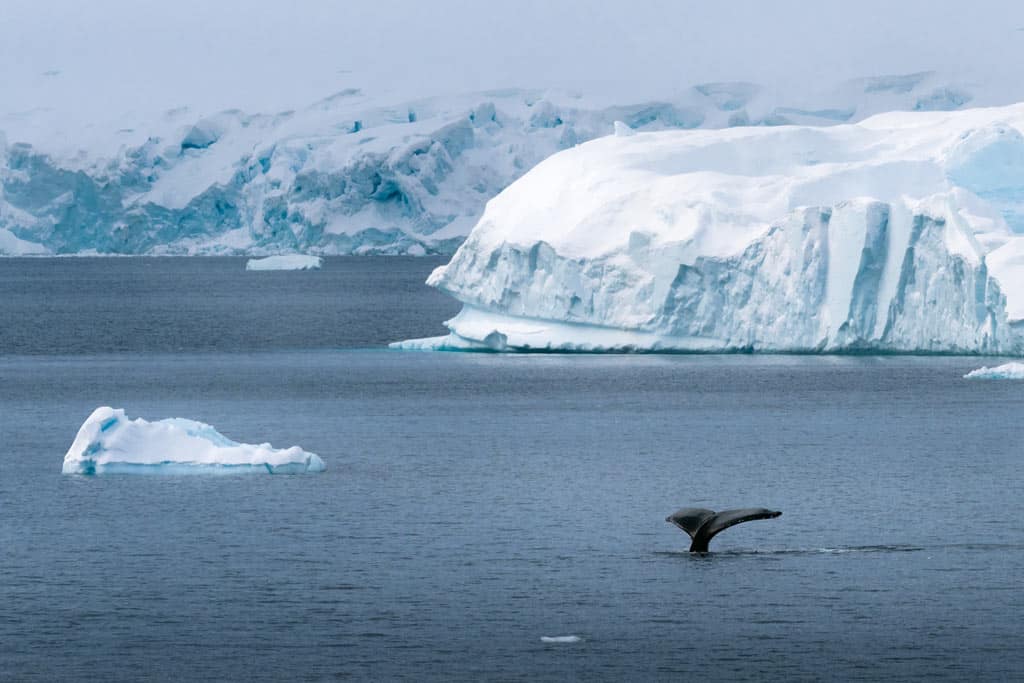
Optional Activities on your Antarctic Cruises
While almost all Antarctic cruises offer shore landings and Zodiac cruises as standard, there’s a whole bunch of optional activities for those eager to try something different down in the continent.
If you’re ready to step up the adventure, here’s a guide on what’s on offer and how to ensure you don’t miss out.
Sea Kayaking
Gliding silently through the icy waters, kayakers get an intimate perspective of Antarctica’s coastlines.
As icebergs loom majestically overhead and seals laze on floating ice, you can navigate through a surreal world rarely experienced by others.
When you book a sea kayaking package you are given a dry suit and instruction from your experienced guides, and the goal is to get out as much as possible during your itinerary.
Most expedition ships that offer kayaking in Antarctica have a limited number of kayaks, so early reservation is crucial.
It’s also only suited for those with some prior sea kayaking experience.
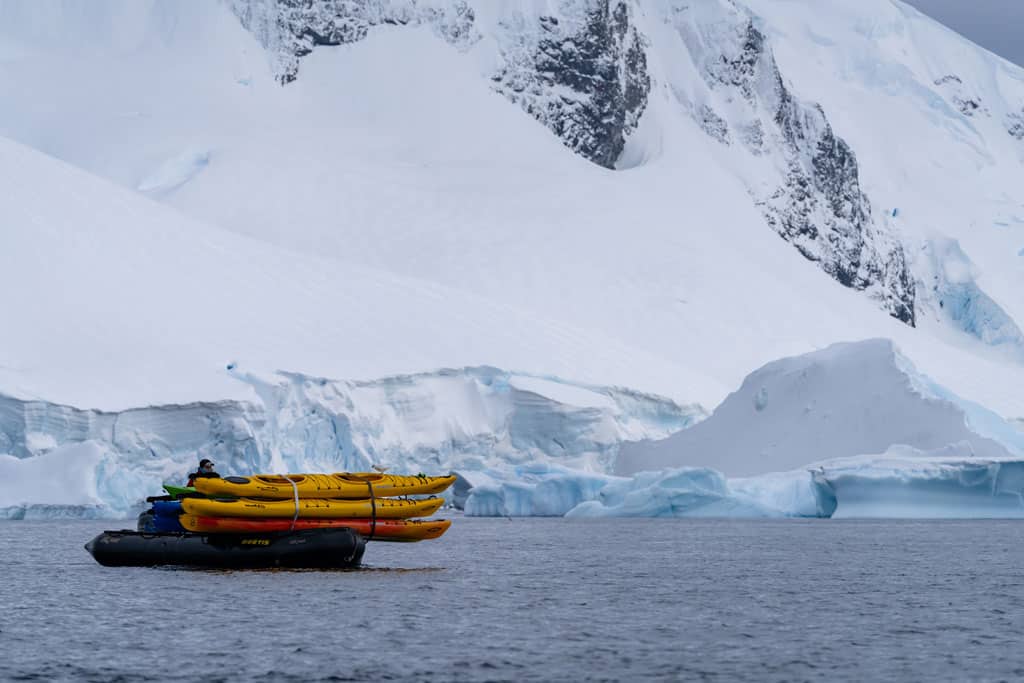
Day Paddling
If you love the idea of kayaking but don’t want to do it every single day on your trip, many companies now offer what’s called ‘day paddle excursions’, where you sign up for a once-off and jump in an inflatable kayak for an hour or two.
It’s absolutely beautiful and is perfect for those that just want to try it once.
Camping
Imagine sleeping under the Antarctic sky, surrounded by snow and ice, with the distant calls of penguins lulling you to sleep.
Sounds majestic doesn’t it?
Truth is it’s not comfortable at all, most people get anxious about it and there’s the fear of being too cold to sleep, but we’ll let you in on a little secret – Camping in Antarctica is nowhere near as bad as it sounds and is the ultimate experience.
You are given strict instructions on how it works and will be given your own bivvy sack to sleep in (not a tent), which is rated to the temperatures down there so you won’t freeze.
Given the stringent environmental regulations and the limited gear available, only a few spots are open per cruise. Book in advance.
Mountaineering and Climbing
If you’re a hardcore mountaineer or experienced rock climber there are a number of small expedition companies that offer these activities on certain itineraries.
With the guidance of expert mountaineers, you can ascend icy peaks or navigate glacial routes for an epic bucket list adventure.
You must be an experienced climber, and be able to prove it, before a company will accept your booking for these challenging adventures.
Skiing and Snowboarding
A couple of companies now also offer skiing and snowboarding trips to Antarctica.
As above, you need to prove you have backcountry skiing/snowboarding experience, all the right gear and avalanche rescue training before you can sign up.
Scuba Diving
Fancy doing a bit of scuba diving in Antarctica? Well you can…on the condition that you have the right tickets and experience.
Diving in Antarctica is a very unique experience where you can see marine mammals, krill and ice, but it does require advanced PADI certification, ice-diving certs and at least 20 logged ice dives.
There’s also only a couple of companies that are equipped for this and it’s quite expensive.
Photography Workshops
While most ships have an expedition photographer onboard whose job it is to document the entire trip, providing the images and videos to the guests at the end, most companies don’t have dedicated photography workshops.
There are some exceptions, Intrepid being a notable one who Jarryd worked with as a photography guide this year, where you join a small group of people to get daily workshops on photography techniques, camera settings, composition, creativity, editing and more.
Citizen Science Programs
For those who wish to contribute to our understanding of this remote region, some companies collaborate with research institutions to allow passengers to participate in data collection and other scientific activities.
Details are often available in cruise itineraries, and early registration ensures you’re part of these enriching experiences.
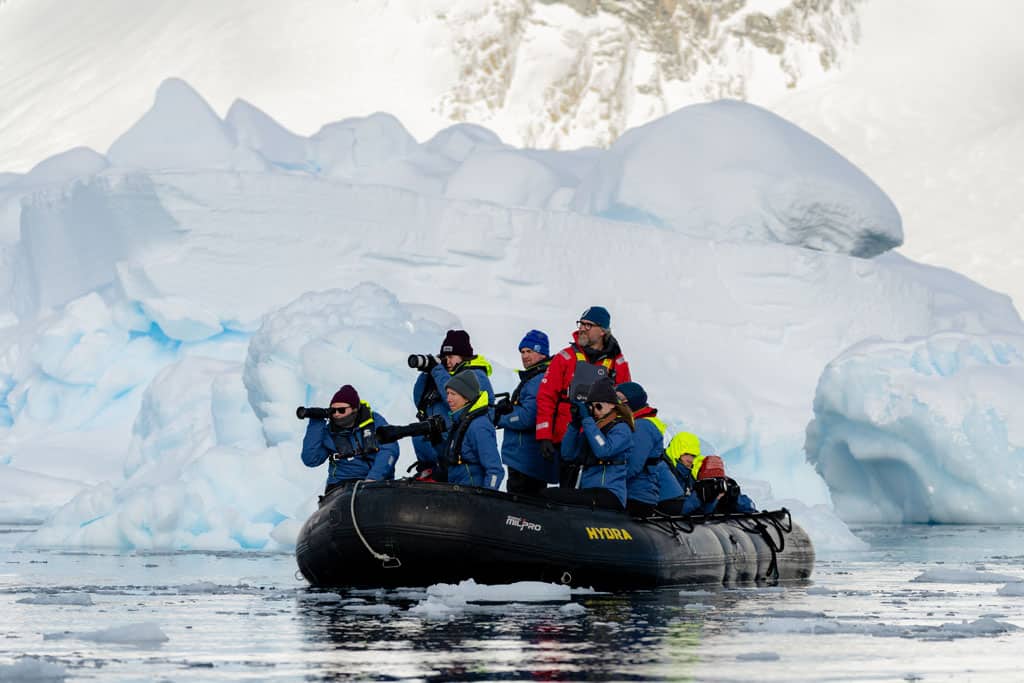
Environmental Responsibility When Choosing an Antarctica Cruise Operator
Finally, remember that it’s a privilege to visit Antarctica and you should always make sure you do so responsibly.
Only every book a trip with a company that is registered of IAATO, which is an official organisation that designates Antarctica purely for the purpose of science and research.
Newer ships produce less emissions and are more fuel efficient, so consider spending a little bit more money for a ship that wasn’t built in the 80s.
Protect the unique wildlife, stunning environment and exploration history of one of the world’s most spectacular places by selecting a reputable company to travel with, like the ones we recommended in this article.

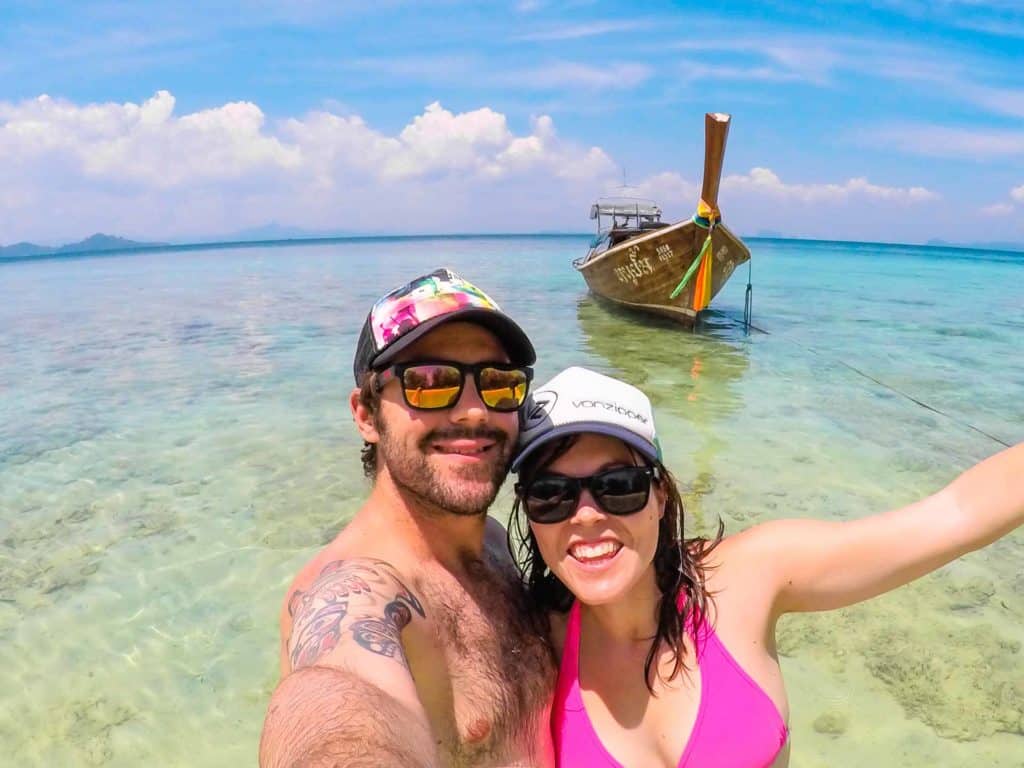
3 thoughts on “Best Antarctica Cruise – Ultimate Guide to Who & How [2025]”
what a great, detailed guide. Antarctica been on my list to do for a number of years now, I will defiantly will visit Antarctica in the next year or two.
thank you
Hi there, Jaseph here!
I just wanted to say a huge thank you to the Nomadasaurus team for this fantastic guide on Antarctica cruises. The insights and personal experiences shared really help in making informed decisions for such an epic adventure. I appreciate the detailed itineraries and tips on choosing the right operator. Can’t wait to start planning my trip!
Thanks again, Jarryd and the team!
Best,
Jaseph
Such a beautiful blog. Please visit us if you want to visit Nepal and have an authentic experience of rural life. We are Community Homestay Network.